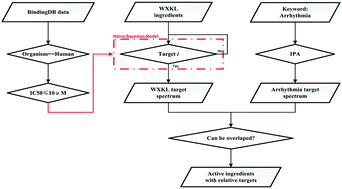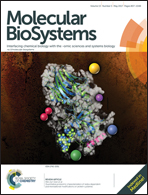An integrated anti-arrhythmic target network of a Chinese medicine compound, Wenxin Keli, revealed by combined machine learning and molecular pathway analysis†
Abstract
Wenxin Keli (WK), a Chinese patent medicine, is known to be effective against cardiac arrhythmias and heart failure. Although a number of electrophysiological findings regarding its therapeutic effect have been reported, the active components and system-level characterizations of the component–target interactions of WK have yet to be elucidated. In the current study, we present the first report of a new protective effect of WK on suppressing anti-arrhythmic-agent-induced arrhythmias. In a model of isolated guinea pig hearts, rapid perfusion of quinidine altered the heart rate and prolonged the Q–T interval. Pretreatment with WK significantly prevented quinidine-induced arrhythmias. To explain the therapeutic and protective effects of WK, we constructed an integrated multi-target pharmacological mechanism prediction workflow in combination with machine learning and molecular pathway analysis. This workflow had the ability to predict and rank the probability of each compound interacting with 1715 target proteins simultaneously. The ROC value statistics showed that 97.786% of the values for target prediction were larger than 0.8. We applied this model to carry out target prediction and network analysis for the identified components of 5 herbs in WK. Using the 124 potential anti-arrhythmic components and the 30 corresponding protein targets obtained, an integrative anti-arrhythmic molecular mechanism of WK was proposed. Emerging drug/target networks suggested ion channel and intracellular calcium and autonomic nervous and hormonal regulation had critical roles in WK-mediated anti-arrhythmic activity. A validation of the proposed mechanisms was achieved by demonstrating that calaxin, one of the WK components from Gansong, dose-dependently blocked its predicted target CaV1.2 channel in an electrophysiological assay.



 Please wait while we load your content...
Please wait while we load your content...